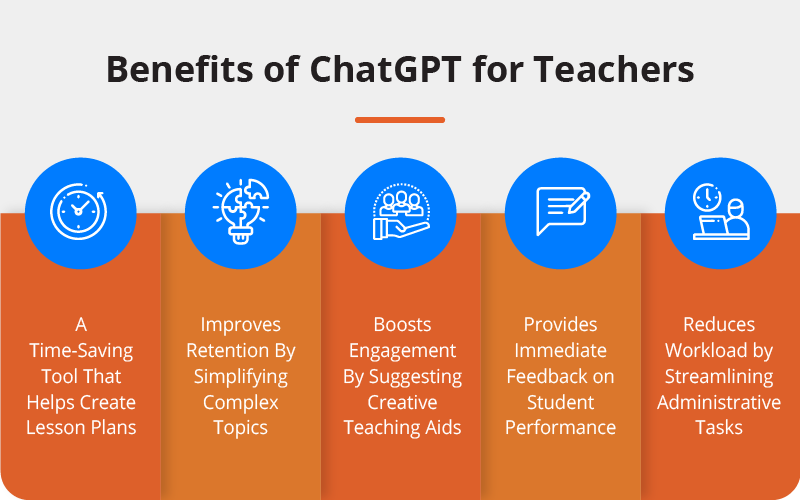Smart Teaching, Smarter Results: A Guide to ChatGPT for Educators

Generative AI technologies such as ChatPGT are transforming the traditional classroom experience and encouraging teachers to redefine instructional practices and methodologies. Yet, there are educators and administrators who still have inhibitions about integrating this powerful technology into the classroom. However, the reality is, ChatGPT is a neutral tool and it entirely depends upon how the teacher would like to integrate it into the classroom.
Teachers wear multiple hats and generally oversee a wide range of responsibilities ranging from research, lesson planning to delivering lectures and grading, among others. This is why any time saving tool that helps them build efficiency such as email, Learning Management Systems (LMS), online planners, etc. can do wonders. As a teacher, if saving time and enhancing your teaching skills is on your mind, ChatGPT is one of the most effective AI-powered assistants that can help you achieve this goal.
Today, we explore the potential benefits of ChatGPT for teachers and how it revolutionizes the classroom experience, with the help of some prompt examples.
Benefits of Using ChatGPT in Education

ChatGPT is being widely used across multiple industries, the education sector being no exception. This versatile tool is known for being one of the most impressive applications of AI that can unlock numerous advantages for teachers. Before we explore the key benefits that ChatGPT poses for educators, let us take a brief look at how ChatGPT exactly works.
ChatGPT is essentially a language model chatbot that was developed by OpenAI back in November 2022. It generates human-like responses to questions, which are fed in the form of prompts. The platform responds to these prompts using conversational dialogue. For example, if a teacher wanted to conduct a quiz session in the classroom, they would use a prompt like ‘Suggest 10 questions with 4 options for a quiz session on (topic name) for (grade level) students.’
Let us now explore the top 3 benefits of using ChatGPT in the education:
#Benefit 1: Personalized Learning
Using ChatGPT gives teachers access to readily available sources of data and information. This helps them curate lesson plans with ease, tailor content based on students’ individual needs and provide them with the guidance they need based on their skills and interests, allowing for more targeted instruction.
#Benefit 2: Speed
ChatGPT enables teachers to process and generate information quickly. This helps them save a considerable amount of time and improves efficiency for both teachers and students. By assisting with tasks such as curating learning content, instant test generation, automation of feedback and grading, ChatGPT allows teachers to direct more of their time and focus towards other aspects of teaching like delivering lectures, student support, etc.
#Benefit 3: Availability
Teachers can access instant assistance, lesson planning support and knowledge reinforcement whenever they need it. ChatGPT’s 24/7 availability empowers teachers with invaluable resources, whether that’s answering student queries, providing real-world examples or grading assessments. It enhances a teacher’s productivity while creating a more effective learning experience for students, round the clock.
How Teachers Can Use ChatGPT to Their Advantage
Teachers can harness the power of ChatGPT to foster a more engaging and effective classroom environment. This powerful AI tool can be used for resolving student queries, providing diverse learning materials, grading assignments, generating performance reports, personalizing instruction and so much more. Let’s take a look five effective approaches to utilizing ChatGPT in the classroom:
1. Research & Brainstorming
Teachers can use ChatGPT to find data on new concepts, generate assignment ideas, develop creative or hypothetical scenarios to engage students in brainstorming, create mind maps or even find guidance on different ways to conduct research. It is a great tool for creative ideation that can also assist teachers with innovative teaching practices, finding insightful case studies and generating real-world examples on key topics.
Prompt for concept exploration: ‘I’m introducing trigonometry in Math class today. Can you generate examples on this topic suited for beginners to help students understand better?’
2. Customize Lesson Plans
Lesson planning is a key aspect of teaching that requires teachers to put in a lot of time, effort, research and creativity into. ChatGPT can help simplify this process for teachers by generating useful content for their lessons, creating a structured lesson plan, giving ideas on discussion prompts that can be used to boost engagement, developing tests and worksheets related to the learning objective and more. This helps instructors save on valuable time and curate learning material tailored to individual student needs.
Prompt for a detailed lesson plan: ‘Can you generate a lesson plan template on ‘Latitudes & Longitudes’ that is best suited for grade 6 students?’
3. Writing Assistance & Feedback
ChatGPT can be a valuable tool to improve students’ writing skills. Teachers can have students submit written assignments or essays to ChatGPT and feed in prompts that can ask it to evaluate their submission, provide constructive feedback and give practical suggestions to improve their writing style. Besides, teachers may also use ChatGPT to generate progress reports and score assessments with the help of the right prompts.
Prompt for generating progress report: ‘Provide a detailed report on the given paragraph. The report should include readability score, vocabulary statistics, grammar and tone type.’
4. Classroom Instructions
Teachers can use ChatGPT as a reference tool to simplify and break down complex topics, answer students’ queries, customize learning paths based on student progress, etc. Moreover, it streamlines communication by helping teachers deliver clear and concise explanations regarding study material and assignments, aiding comprehension for diverse learners.
Prompt for enhancing classroom instructions: ‘Generate a list of classroom rules and actionable ways through which students can meet these expectations’.
5. Language Learning Support
Teachers can use ChatGPT to help students practice their vocabulary, grammar and conversational skills. They can simulate real-life dialogues, generate sample sentences, correct grammatical errors and engage in interactive language exercises to help students practice and improve their proficiency.
Prompt for practicing language learning: ‘I would like to practice a conversational dialogue in French with my students. Generate some short questions with responses.’
Beyond ChatGPT, if you’d like to experience cutting-edge digital tools, check out Extramarks School Solutions. It features a combination of powerful smart class solutions, interactive classrooms with complete learning resources and a solid AI-backed assessment center; providing a technology-enhanced teaching experience.
In conclusion, using ChatGPT in the classroom elevates the teaching experience in remarkable ways. It empowers educators to be more creative, productive, responsive and efficient in their instruction. By embracing this powerful AI-based technology tool and integrating it in the classroom, teachers can craft dynamic and adaptive learning environments that equip students with 21st century skills.
Last Updated on February 17, 2025
Reviewed by

Prachi Singh | VP - Academics
Prachi Singh is a highly accomplished educationist with over 16 years of experience in the EdTech industry. Currently, she plays a pivotal role at Extramarks, leading content strategy and curriculum development initiatives that shape the future of education...read more.










